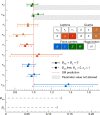A detailed map of Higgs boson interactions by the ATLAS experiment ten years after the discovery
- PMID: 35788192
- PMCID: PMC9259483
- DOI: 10.1038/s41586-022-04893-w
A detailed map of Higgs boson interactions by the ATLAS experiment ten years after the discovery
Erratum in
-
Publisher Correction: A detailed map of Higgs boson interactions by the ATLAS experiment ten years after the discovery.Nature. 2022 Dec;612(7941):E24. doi: 10.1038/s41586-022-05581-5. Nature. 2022. PMID: 36474075 Free PMC article. No abstract available.
-
Author Correction: A detailed map of Higgs boson interactions by the ATLAS experiment ten years after the discovery.Nature. 2023 Nov;623(7985):E5. doi: 10.1038/s41586-023-06248-5. Nature. 2023. PMID: 37853131 Free PMC article. No abstract available.
Abstract
The standard model of particle physics1-4 describes the known fundamental particles and forces that make up our Universe, with the exception of gravity. One of the central features of the standard model is a field that permeates all of space and interacts with fundamental particles5-9. The quantum excitation of this field, known as the Higgs field, manifests itself as the Higgs boson, the only fundamental particle with no spin. In 2012, a particle with properties consistent with the Higgs boson of the standard model was observed by the ATLAS and CMS experiments at the Large Hadron Collider at CERN10,11. Since then, more than 30 times as many Higgs bosons have been recorded by the ATLAS experiment, enabling much more precise measurements and new tests of the theory. Here, on the basis of this larger dataset, we combine an unprecedented number of production and decay processes of the Higgs boson to scrutinize its interactions with elementary particles. Interactions with gluons, photons, and W and Z bosons-the carriers of the strong, electromagnetic and weak forces-are studied in detail. Interactions with three third-generation matter particles (bottom (b) and top (t) quarks, and tau leptons (τ)) are well measured and indications of interactions with a second-generation particle (muons, μ) are emerging. These tests reveal that the Higgs boson discovered ten years ago is remarkably consistent with the predictions of the theory and provide stringent constraints on many models of new phenomena beyond the standard model.
© 2022. The Author(s).
Conflict of interest statement
The authors declare no competing interests.
Figures







References
-
- Weinberg S. A model of leptons. Phys. Rev. Lett. 1967;19:1264–1266. doi: 10.1103/PhysRevLett.19.1264. - DOI
-
- Glashow SL. Partial symmetries of weak interactions. Nucl. Phys. 1961;22:579–588. doi: 10.1016/0029-5582(61)90469-2. - DOI
-
- Salam A. Weak and electromagnetic interactions. Proc. 8th Nobel Symposium, Conf. Proc. C. 1968;680519:367–377.
-
- ’t Hooft G, Veltman MJG. Regularization and renormalization of gauge fields. Nucl. Phys. B. 1972;44:189–213. doi: 10.1016/0550-3213(72)90279-9. - DOI
-
- Higgs PW. Broken symmetries, massless particles and gauge fields. Phys. Lett. 1964;12:132–133. doi: 10.1016/0031-9163(64)91136-9. - DOI

